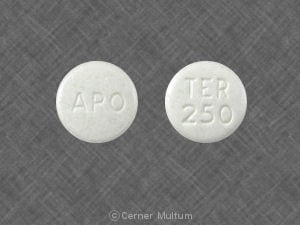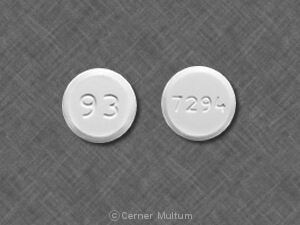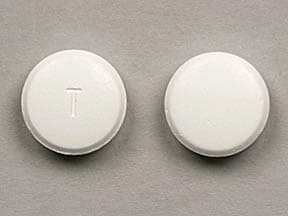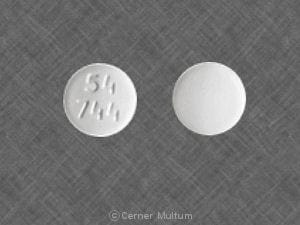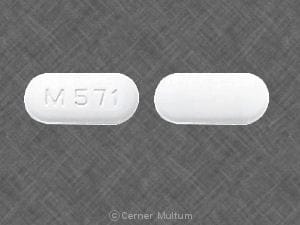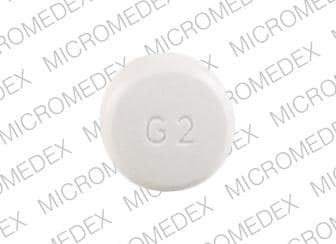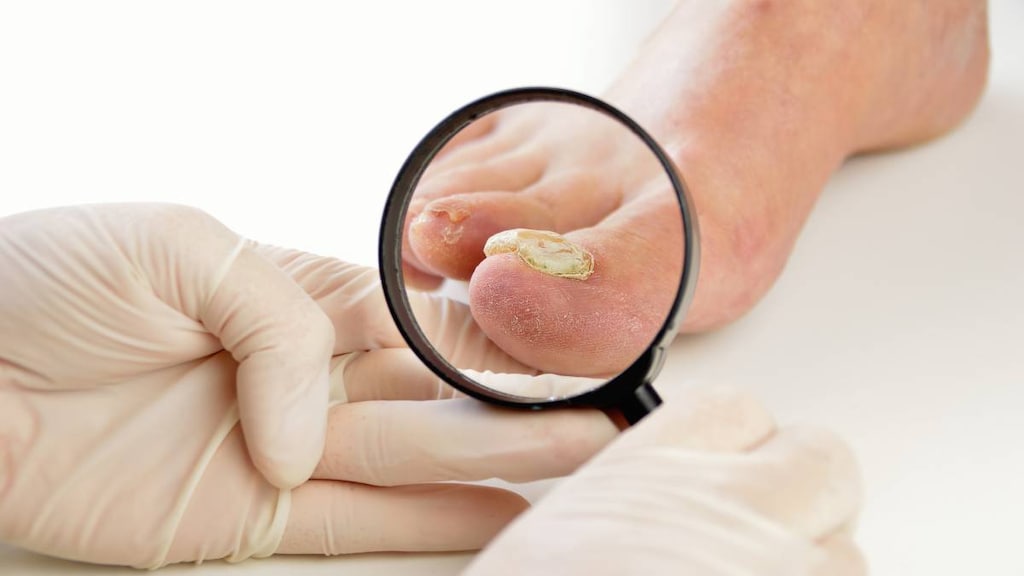Dosage Forms
Excipient information presented when available (limited, particularly for generics); consult specific product labeling. [DSC] = Discontinued product
Packet, Oral:
LamISIL: 125 mg (1 ea [DSC], 14 ea [DSC]); 187.5 mg (1 ea [DSC], 14 ea [DSC]) [contains polyethylene glycol]
Tablet, Oral:
LamISIL: 250 mg [DSC]
Generic: 250 mg
Pharmacology
Mechanism of Action
Synthetic allylamine derivative that inhibits squalene epoxidase, a key enzyme in sterol biosynthesis in fungi. This results in a deficiency in ergosterol within the fungal cell membrane and results in fungal cell death.
Pharmacokinetics/Pharmacodynamics
Absorption
Children and Adults: >70%
Distribution
Distributed to sebum and skin predominantly
Metabolism
Hepatic predominantly via CYP1A2, 3A4, 2C8, 2C9, and 2C19 to inactive metabolites
Excretion
Urine (80%, primarily as inactive metabolites); feces (20%) (Debruyne 2001)
Clearance: Children (14 to 68 kg): 15.6 to 26.7 L/hour
Time to Peak
Plasma: Children and Adults: Within 2 hours
Half-Life Elimination
Terminal half-life: 200 to 400 hours; very slow release of drug from skin and adipose tissues occurs; effective half-life: Children: 27 to 31 hours; Adults: ~36 hours
Protein Binding
Plasma: >99%
Use in Specific Populations
Special Populations: Renal Function Impairment
In CrCl ≤50 mL/minute, terbinafine clearance is decreased 50%.
Special Populations: Hepatic Function Impairment
In hepatic cirrhosis, terbinafine clearance is decreased 50%.
Use: Labeled Indications
Onychomycosis (tablets only): Treatment of onychomycosis of the toenail or fingernail caused by dermatophytes (tinea unguium).
Tinea capitis (granules only): Treatment of tinea capitis in patients 4 years and older.
Use: Off Label
Dermatophyte folliculitis (tinea barbae, Majocchi granuloma)c
Data from a limited number of patients studied suggest that terbinafine may be beneficial for the treatment of dermatophyte folliculitis Bonifaz 2003, Chou 2016, Gega 2010, Wang 2018, Zhou 2017; clinical experience also suggests the utility of terbinafine in managing dermatophyte folliculitis Ilkit 2012, Jackson 2019.
Sporotrichosis (lymphocutaneous and cutaneous)yes
Based on the Infectious Diseases Society of America (IDSA) guidelines for the management of sporotrichosis, terbinafine (systemic) is an effective and recommended treatment option for patients with lymphocutaneous and cutaneous sporotrichosis who do not respond to first-line therapy with itraconazole IDSA [Kauffman 2007].
Tinea capitisc
Data from a limited number of patients studied suggest terbinafine tablets may be beneficial for the treatment of tinea capitis El-Khalawany 2013; clinical experience also suggests the utility of terbinafine tablets in managing tinea capitis Gupta 2008, Treat 2019.
Tinea corporis/tinea cruris/tinea facieib
Data from a double-blind, randomized clinical study suggest that oral terbinafine may be effective in the treatment of widespread tinea corporis/tinea cruris del Palacio Hernandez 1990. Additional data from a limited number of patients studied also suggest terbinafine may be beneficial in the treatment of tinea corporis/tinea cruris Farag 1994, Voravutinon 1993; clinical experience suggests the utility of terbinafine in managing tinea corporis/tinea cruris/tinea faciei Gupta 2008, Hawkins 2014.
Tinea pedis/tinea manuuma
Data from 2 double-blind, randomized studies support the use of oral terbinafine in the treatment of tinea pedis and tinea manuum
Contraindications
Hypersensitivity to terbinafine or any component of the formulation; chronic or active hepatic disease
Dosage and Administration
Dosing: Adult
Note: Lamisil granules have been discontinued in the United States for more than 1 year.
Onychomycosis:
Continuous dosing: Oral: Tablet: 250 mg once daily for 6 weeks (fingernail) or 12 weeks (toenail).
Pulsed dosing (alternative dosing method) (off-label): Oral: Tablet: 250 mg once daily for 4 weeks, off for 4 weeks, then resume with 250 mg once daily for 4 weeks (Gupta 2013) or 250 mg twice daily for 1 week repeated every 4 weeks for 3 months (Takahata 2009; Yadav 2015). Note: Pulsed dosing is less effective but may reduce the risk of adverse effects, reduce cost, and improve patient compliance (Goldstein 2019).
Sporotrichosis, lymphocutaneous and cutaneous (alternative agent for patients who do not respond to itraconazole) (off-label use): Oral: Tablet: 500 mg twice daily (IDSA [Kauffman 2007]). Treat for 2 to 4 additional weeks after all lesions have resolved; usual duration is 3 to 6 months (Chapman 2004; IDSA [Kauffman 2007]).
Tinea infections:
Dermatophyte folliculitis (tinea barbae, Majocchi granuloma) (off-label use): Oral: Tablet: 250 mg once daily; duration is typically 2 to 6 weeks but may need to be extended (eg, in immunocompromised patients with slow response) (Bonifaz 2003; Chou 2016; Gega 2010; Ilkit 2012; Jackson 2019; Wang 2018; Zhou 2017).
Tinea capitis (off-label use): Oral: Tablet: 250 mg once daily for 4 to 6 weeks (El-Khalawany 2013; Gupta 2008; Treat 2019).
Tinea corporis/tinea cruris/tinea faciei (alternative agent) (off-label use): Note: Alternative treatment for patients with extensive skin involvement or in whom topical therapy failed.
Oral: Tablet: 250 mg once daily for 1 to 2 weeks (del Palacio Hernandez 1990; Farag 1994; Gupta 2008; Voravutinon 1993).
Tinea pedis/tinea manuum (alternative agent) (off-label use): Note: Alternative treatment for patients with extensive skin involvement or in whom topical therapy failed.
Oral: Tablet: 250 mg once daily for 2 weeks (Bell-Syer 2012; Gupta 2008; Tausch 1998; White 1991).
Dosing: Geriatric
Use with caution; refer to adult dosing.
Dosing: Pediatric
Note: Lamisil granules have been discontinued in the US for more than 1 year.
Tinea capitis: Children ≥4 years and Adolescents: Oral: Granules:
<25 kg: 125 mg once daily for 6 weeks
25 to 35 kg: 187.5 mg once daily for 6 weeks
>35 kg: 250 mg once daily for 6 weeks
Onychomycosis: Limited data available (Gupta 1997): Children and Adolescents: Oral: Tablets:
10 to 20 kg: 62.5 mg once daily for 6 weeks (fingernails) or 12 weeks (toenails)
20 to 40 kg: 125 mg once daily for 6 weeks (fingernails) or 12 weeks (toenails)
>40 kg: 250 mg once daily for 6 weeks (fingernails) or 12 weeks (toenails)
Extemporaneously Prepared
A 25 mg/mL oral suspension may be made using tablets. Crush twenty 250 mg tablets and reduce to a fine powder. Add small amount of a 1:1 mixture of Ora-Sweet® and Ora-Plus® and mix to a uniform paste; mix while adding the vehicle in geometric proportions to almost 200 mL; transfer to a calibrated bottle, rinse mortar with vehicle, and add quantity of vehicle sufficient to make 200 mL. Label "shake well" and "refrigerate". Stable 42 days.
Nahata MC, Pai VB, and Hipple TF, Pediatric Drug Formulations, 5th ed, Cincinnati, OH: Harvey Whitney Books Co, 2004.
Administration
Administer tablets without regard to meals. Administer granules with food; sprinkle granules on a spoonful of pudding or other soft, nonacidic food (eg, mashed potatoes); swallow entire spoonful without chewing; do not mix granules with applesauce or other fruit-based foods.
Storage
Granules: Store at 25°C (77°F); excursions permitted between 15°C to 30°C (59°F to 86°F).
Tablets: Store below 25°C (77°F). Protect from light.
Terbinafine (Systemic) Images
Drug Interactions
Ajmaline: CYP2D6 Inhibitors (Moderate) may increase the serum concentration of Ajmaline. Monitor therapy
Amitriptyline: Terbinafine (Systemic) may increase the serum concentration of Amitriptyline. Management: Monitor for increased effects/toxicity of amitriptyline during concomitant administration with terbinafine. Reduced dosages of amitriptyline may be needed. Consider therapy modification
Amphetamines: CYP2D6 Inhibitors (Moderate) may increase the serum concentration of Amphetamines. Monitor therapy
ARIPiprazole: CYP2D6 Inhibitors (Moderate) may increase the serum concentration of ARIPiprazole. Management: Monitor for increased aripiprazole pharmacologic effects. Aripiprazole dose adjustments may or may not be required based on concomitant therapy and/or indication. Consult full interaction monograph for specific recommendations. Monitor therapy
Brexpiprazole: CYP2D6 Inhibitors (Moderate) may increase the serum concentration of Brexpiprazole. Management: If brexpiprazole is to be used together with both a moderate CYP2D6 inhibitor and a strong or moderate CYP3A4 inhibitor, the brexpiprazole dose should be reduced to 25% of the usual dose. Monitor therapy
CloZAPine: CYP2D6 Inhibitors (Moderate) may increase the serum concentration of CloZAPine. Monitor therapy
Codeine: CYP2D6 Inhibitors (Moderate) may diminish the therapeutic effect of Codeine. These CYP2D6 inhibitors may prevent the metabolic conversion of codeine to its active metabolite morphine. Monitor therapy
CYP2D6 Substrates (High risk with Inhibitors): CYP2D6 Inhibitors (Moderate) may decrease the metabolism of CYP2D6 Substrates (High risk with Inhibitors). Exceptions: Tamoxifen. Monitor therapy
Desipramine: Terbinafine (Systemic) may increase the serum concentration of Desipramine. Management: Monitor for increased effects/toxicity of desipramine during concomitant administration with terbinafine. Reduced dosages of desipramine may be needed. Consider therapy modification
DOXOrubicin (Conventional): CYP2D6 Inhibitors (Moderate) may increase the serum concentration of DOXOrubicin (Conventional). Management: Seek alternatives to moderate CYP2D6 inhibitors in patients treated with doxorubicin whenever possible. One U.S. manufacturer (Pfizer Inc.) recommends that these combinations be avoided. Consider therapy modification
Eliglustat: CYP2D6 Inhibitors (Moderate) may increase the serum concentration of Eliglustat. Management: Reduce the eliglustat dose to 84 mg daily. Avoid use of eliglustat in combination with a moderate CYP2D6 inhibitor and a strong or moderate CYP3A4 inhibitor. Consider therapy modification
Fesoterodine: CYP2D6 Inhibitors may increase serum concentrations of the active metabolite(s) of Fesoterodine. Monitor therapy
Imipramine: Terbinafine (Systemic) may increase the serum concentration of Imipramine. Management: Monitor for increased effects/toxicity of imipramine during concomitant administration with terbinafine. Reduced dosages of imipramine may be needed. Consider therapy modification
Indoramin: CYP2D6 Inhibitors (Moderate) may increase the serum concentration of Indoramin. Monitor therapy
Metoprolol: CYP2D6 Inhibitors (Moderate) may increase the serum concentration of Metoprolol. Monitor therapy
Nebivolol: CYP2D6 Inhibitors (Moderate) may increase the serum concentration of Nebivolol. Monitor therapy
Nortriptyline: Terbinafine (Systemic) may increase the serum concentration of Nortriptyline. Management: Monitor for increased effects/toxicity of nortriptyline during concomitant administration with terbinafine. Reduced dosages of nortriptyline may be needed. Consider therapy modification
Perhexiline: CYP2D6 Inhibitors may increase the serum concentration of Perhexiline. Management: Consider alternatives to this combination if possible. If combined, monitor for increased perhexiline serum concentrations and toxicities (eg, hypoglycemia, neuropathy, liver dysfunction). Perhexiline dose reductions will likely be required. Consider therapy modification
Pitolisant: CYP2D6 Inhibitors (Moderate) may increase the serum concentration of Pitolisant. Monitor therapy
Propafenone: CYP2D6 Inhibitors (Moderate) may increase the serum concentration of Propafenone. Management: Drugs listed as exceptions to this monograph are discussed in further detail in separate drug interaction monographs. Monitor therapy
RifAMPin: May decrease the serum concentration of Terbinafine (Systemic). Monitor therapy
Saccharomyces boulardii: Antifungal Agents (Systemic, Oral) may diminish the therapeutic effect of Saccharomyces boulardii. Avoid combination
Tamoxifen: CYP2D6 Inhibitors (Moderate) may decrease serum concentrations of the active metabolite(s) of Tamoxifen. Specifically, CYP2D6 inhibitors may decrease the metabolic formation of highly potent active metabolites. Management: Consider alternatives with less of an inhibitory effect on CYP2D6 activity when possible. Consider therapy modification
Tamsulosin: CYP2D6 Inhibitors (Moderate) may increase the serum concentration of Tamsulosin. Monitor therapy
Thioridazine: CYP2D6 Inhibitors may increase the serum concentration of Thioridazine. Avoid combination
TraMADol: CYP2D6 Inhibitors (Moderate) may diminish the therapeutic effect of TraMADol. These CYP2D6 inhibitors may prevent the metabolic conversion of tramadol to its active metabolite that accounts for much of its opioid-like effects. Monitor therapy
Adverse Reactions
>10%: Central nervous system: Headache (7% to 13%)
1% to 10%:
Dermatologic: Skin rash (6%; children: 2%), pruritus (1% to 3%), urticaria (1%)
Gastrointestinal: Diarrhea (3% to 6%), vomiting (<1%; children: 5%), dyspepsia (4%), upper abdominal pain (children: 4%), dysgeusia (3%; may be severe and result in weight loss, anxiety, and depression), nausea (2% to 3%), abdominal pain (children: 2%), pharyngolaryngeal pain (children: 2%), toothache (children: 1%)
Hepatic: Liver enzyme disorder (3%)
Infection: Influenza (children: 2%)
Ophthalmic: Vision color changes (children: 5%; color confusion), decreased visual acuity (children: 1% to 2%)
Respiratory: Nasopharyngitis (children: 10%), cough (children: 6%), upper respiratory tract infection (children: 5%), nasal congestion (children: 2%), rhinorrhea (children: 2%)
Miscellaneous: Fever (<1%; children: 7%)
<1%, postmarketing, and/or case reports: Acute generalized exanthematous pustulosis, ageusia, agranulocytosis, alopecia, altered sense of smell, anaphylaxis, anemia, angioedema, anosmia, anxiety, arthralgia, auditory impairment, bullous dermatitis, cholestasis, cutaneous lupus erythematosus, depression, DRESS syndrome, erythema multiforme, exacerbation of psoriasis, exacerbation of systemic lupus erythematosus, exfoliative dermatitis, fatigue, flu-like symptoms, hemolytic-uremic syndrome, hepatic insufficiency, hepatic failure, hepatitis, hypersensitivity reaction, hypoesthesia, increased creatine phosphokinase, lens disease, malaise, myalgia, pancreatitis, pancytopenia, paresthesia, psoriasiform eruption, retinopathy, rhabdomyolysis, serum sickness-like reaction, severe neutropenia, skin photosensitivity, Stevens-Johnson syndrome, systemic lupus erythematosus, thrombocytopenia, thrombotic thrombocytopenic purpura, tinnitus, toxic epidermal necrolysis, vasculitis, vertigo, visual field defect
Warnings/Precautions
Concerns related to adverse effects:
- Allylamine antifungal hypersensitivity: Use caution in patients sensitive to allylamine antifungals (eg, naftifine, butenafine); cross-sensitivity to terbinafine may exist.
- Depression: Has been reported with use; instruct patients to report depressive symptoms/mood changes.
- Gastrointestinal effects: Taste disturbance (including loss of taste) may occur and severe cases resulting in decreased food intake, weight loss, anxiety or depression have been reported; resolution may be delayed (eg, several weeks to >1 year) following discontinuation of therapy or in some cases, disturbance may be permanent. Discontinue therapy in patients with symptoms of taste disturbance.
- Hematologic effects: Transient decreases in absolute lymphocyte counts were observed in clinical trials; severe neutropenia (reversible upon discontinuation) has also been reported. Monitor CBC in patients with preexisting immunosuppression if therapy is to continue >6 weeks. Discontinue therapy if ANC ≤1,000/mm3.
- Hepatic failure: Cases of hepatic failure, some leading to liver transplant or death, have been reported. May occur in patients with and without preexisting hepatic disease; severity of hepatic events and/or outcomes may be worse in patients with active or chronic hepatic disease. Perform baseline and periodic liver function tests; discontinue use if clinical evidence of liver injury develops (eg, nausea, anorexia, fatigue, vomiting, right upper abdominal pain, jaundice, dark urine, pale stools) or elevated liver function tests occur.
- Hypersensitivity: Serious skin and hypersensitivity reactions (eg, Stevens-Johnson syndrome, toxic epidermal necrolysis, erythema multiforme, exfoliative dermatitis, bullous dermatitis, drug reaction with eosinophilia and systemic symptoms [DRESS] syndrome) have occurred. If progressive skin rash or signs and symptoms of a hypersensitivity reaction occur, discontinue treatment.
- Ocular effects: Although rare, changes in the ocular lens and retina have been reported; discontinuation of therapy may be required.
- Respiratory effects: Smell disturbance (including loss of smell) has been reported; resolution may be delayed (eg, >1 year) following discontinuation of therapy or in some cases, disturbance may be permanent. Discontinue therapy in patients with symptoms of smell disturbance.
- Thrombotic microangiopathy: Cases of thrombotic microangiopathy (TMA), including thrombotic thrombocytopenic purpura and hemolytic uremic syndrome, have been reported (some fatal). Discontinue if TMA occurs; consider diagnosis of TMA with unexplained thrombocytopenia and anemia.
Disease-related concerns:
- Autoimmune disease (Lupus): Precipitation or exacerbation of cutaneous or systemic lupus erythematosus has been observed; discontinue if signs and/or symptoms develop.
- Hepatic impairment: Use is contraindicated in patients with active or chronic hepatic disease; clearance is reduced by ~50% in hepatic cirrhosis.
- Renal impairment: Use with caution in patients with renal dysfunction (CrCl ≤50 mL/minute); clearance is reduced by ~50%.
Other warnings/precautions:
- Appropriate use: Due to potential toxicity, confirmation of diagnostic testing of nail or skin specimens prior to treatment of onychomycosis or dermatomycosis is recommended.
Monitoring Parameters
Liver function tests at baseline and periodically during treatment; CBC (if used >6 weeks; immunosuppressed patients only); taste and/or smell disturbances
Pregnancy
Pregnancy Considerations
Published information related to the use of systemic terbinafine in pregnancy is limited (Gupta 1997; Sarkar 2003).
Systemic therapy for the treatment of onychomycosis or tinea capitis is not recommended during pregnancy (Kaul 2017; Murase 2014).
Patient Education
What is this drug used for?
- It is used to treat fungal infections of the nails.
- It is used to treat fungal infections of the scalp.
- It may be given to you for other reasons. Talk with the doctor.
Frequently reported side effects of this drug
- Headache
- Abdominal pain
- Common cold symptoms
- Diarrhea
- Passing gas
- Vomiting
- Nausea
Other side effects of this drug: Talk with your doctor right away if you have any of these signs of:
- Thrombotic thrombocytopenic purpura/hemolytic uremic syndrome like bruising or bleeding; severe loss of strength and energy; dark urine or yellow skin; pale skin; change in amount of urine passed; vision changes; change in strength on one side is greater than the other, difficulty speaking or thinking, change in balance; or fever.
- Infection
- Liver problems like dark urine, fatigue, lack of appetite, nausea, abdominal pain, light-colored stools, vomiting, or yellow skin.
- Lupus like rash on the cheeks or other body parts, sunburn easy, muscle or joint pain, chest pain or shortness of breath, or swelling in the arms or legs.
- Swollen glands
- Cough
- Chest pain
- Fast heartbeat
- Blood in the urine
- Change in taste
- Loss of taste
- Change in smell
- Loss of smell
- Weight loss
- Depression
- Lack of appetite
- Stevens-Johnson syndrome/toxic epidermal necrolysis like red, swollen, blistered, or peeling skin (with or without fever); red or irritated eyes; or sores in mouth, throat, nose, or eyes.
- Signs of a significant reaction like wheezing; chest tightness; fever; itching; bad cough; blue skin color; seizures; or swelling of face, lips, tongue, or throat.
Note: This is not a comprehensive list of all side effects. Talk to your doctor if you have questions.
Consumer Information Use and Disclaimer: This information should not be used to decide whether or not to take this medicine or any other medicine. Only the healthcare provider has the knowledge and training to decide which medicines are right for a specific patient. This information does not endorse any medicine as safe, effective, or approved for treating any patient or health condition. This is only a brief summary of general information about this medicine. It does NOT include all information about the possible uses, directions, warnings, precautions, interactions, adverse effects, or risks that may apply to this medicine. This information is not specific medical advice and does not replace information you receive from the healthcare provider. You must talk with the healthcare provider for complete information about the risks and benefits of using this medicine.
